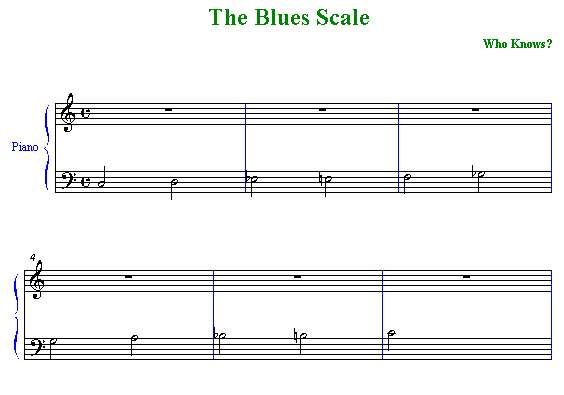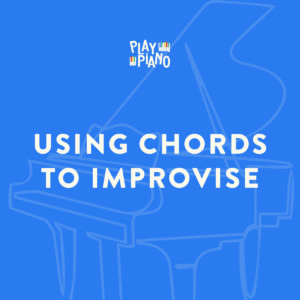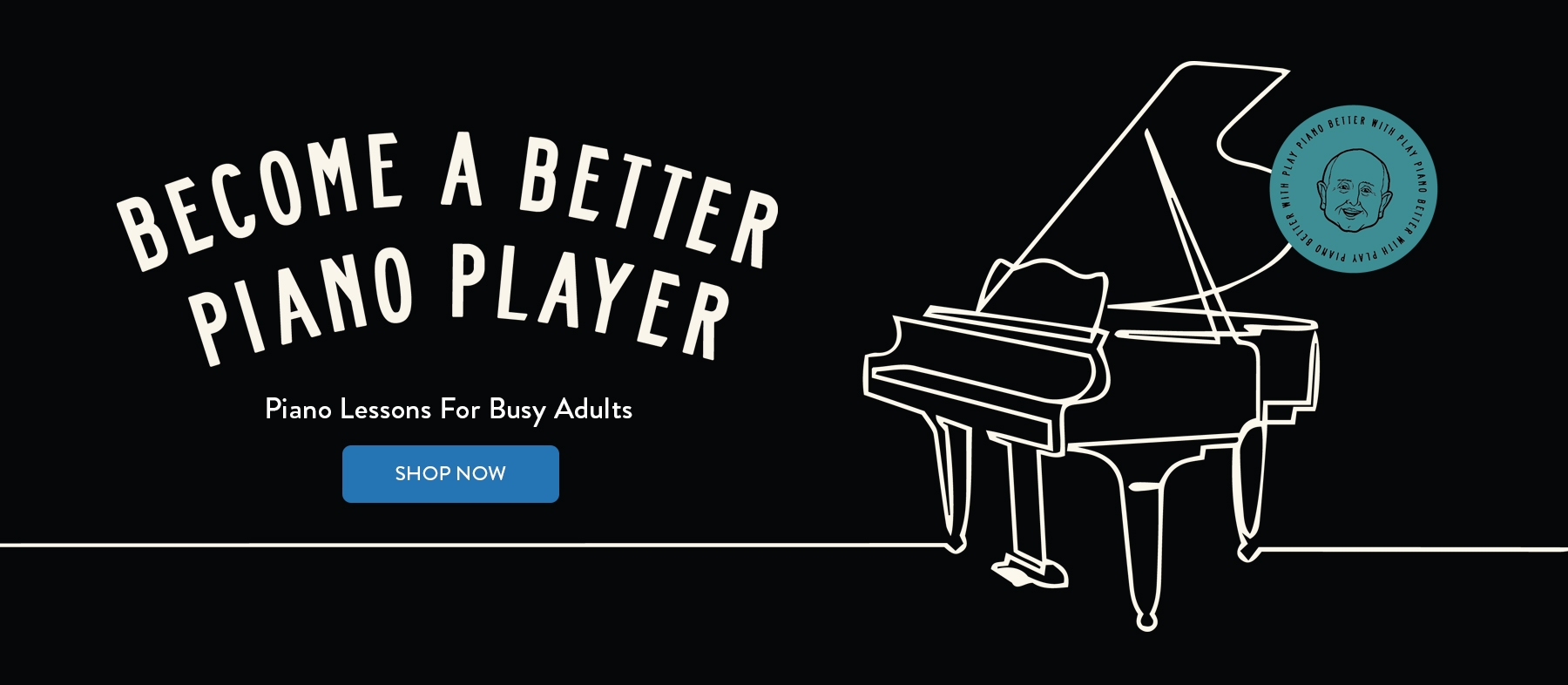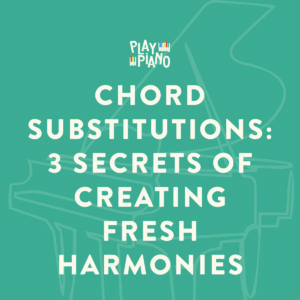Secrets of Exciting Chords & Chord Progressions: Lesson Thirty-Two
Chord Progressions Part 13:
“Enlarging the ’12 Bar Blues’ Chord Progression Through the Use of ‘Embedded Chord Subs'”
Last time we learned the 12-bar blues progression — hope you have it down cold by now, as you will use it your entire musical life in scads of songs — many of them not even known as “blues” songs.
Today we’re going to learn how we can make the 12-bar blues progression much more interesting and complex through the use of embedded chord subs.
First, though — let’s take a brief review of the original progression:
The 12-bar blues is all-American. It developed right here, and until the last few years, it’s main musicians were right here in the US. I had the privilege not long ago of standing on the corner of Bourbon St. and listening to the musicians in Preservation Hall play some of the most authentic blues I’ve heard.
You simply play 12 measures of the same chord progression over and over, each time improvising some different melody on top of those changes. And those changes are:
| The 12 Bar Blues Chord Progression 4 bars of the I chord 2 bars of the IV chord 2 bars of the I chord 1 bar of the V chord 1 bar of the IV chord 2 bars of the I chord |
The 7th is usually added to each chord — so if the I chord is F, you would usually play F7 — that is kind of assumed in the blues.
Start by watching this video of me playing the blues in the key of F at a moderately slow tempo:
As you can see, the structure of the 12 bar blues is very simple. And since it is fun, play it over and over again until you get the sounds you want!
The “melody” of the 12-bar blues is something that each musician makes up as he/she goes along. It is based on the blues scale, which is a bit different than the regular diatonic scale we all grew up with — it includes all those “regular” notes, but also uses the flat 3rd, the flat 5th, and the flat 7th degrees of the scale.
Here is the blues scale in the key of C:

|  The “blues scale” is really a combination of the major diatonic scale (the “regular” scale we all grew up with) plus three additional notes: The flatted 3rd; The flatted 5th (or sharp 4th — same thing);    The flatted 7th; |
So the blues scale really contains 11 notes — the 8 of the normal diatonic scale — and the 3 “blue notes”.
These are used in various combinations, as we shall see, to create a “bluesy sound”.
The blues started not as a piano style, but as a vocal style, and of course the human voice can sing “in the cracks” between
the notes on the keyboard. So when we play blues on the keyboard, we try to imitate the human voice by playing BOTH the 3rd and the flat 3rd — BOTH the 5th and the flat 5th — BOTH the 7th and the flat 7th. We would play in the cracks if we could, but we can’t, so we do the best we can by combining the intervals to imitate the quarter steps that a human voice can sing. (Certain instruments can do that too — for example, the trombone. Since it has a slide, it can hit an infinite number of tones between any two keyboard notes.)
Later we’ll have a lesson on voicing the 12 bar blues, but for now, just learn the form and practice it in all the keys.”Enlarging the ’12 Bar Blues’ Chord Progression Through the Use of ‘Embedded Chord Subs'”Last issue we looked at the skeleton of the 12 bar blues (last issue is re-printed above, so you can refer to it if you need to).
Today let’s look first at some chord substitutions we can insert into the skeleton, and then take a look at creating a melody to go with the chords.
First of all, remember to use 7ths on all the I, IV, and V chords — in other words, I7, IV7, and V7. That will give you are more “bluesy” sound right off the bat. Then to that add some 9ths for a fuller sound. For example, let’s say you’re playing the blues in Bb. To the I chord you would add a 7th, which of course is Ab. If you add a 9th for fullness, that would be a C. So the chord would be made up of Bb, D, F, Ab, and C. One way to voice this chord would be to play a low Bb on the first beat, then on subsequent beats play a chord made up of F, Ab, C, and D. On the IV chord, that would translate to a low Eb, then Bb, Db, F, and G. On the V chord it would be a low F, then C, Eb, F, and G.
Next, use some half-step slides as chord subs. For example, as you move from the I chord to the IV chord, you could “slide in” to the IV chord by playing the 7th or 9th chord 1/2 step above the target chord — in other words, E7 or E9th to Eb7th or 9th. It’s like sliding into a base in baseball: you play the chord 1/2 step higher on the 4th beat (or even on the “and” after the 4th beat) as you move to the next chord. As you move from F7 to Bb7, you could play B7th on the 4th beat of the measure right before you play Bb7th.
Another chord substitution would be to se a suspension on any one of the primary chords before resolving to the chord itself. For example, let’s say you are playing the Bb7 chord but your next chord is Eb7.
Instead of playing Eb7th right away, play Eb7sus for one or two beats before resolving to Eb7. You can do that on any of the chords, and it adds lots of interest to the progression because of the variety and also because of the suspense a suspension creates before it is resolved.
Another way to create a chord substitution is to substitute a minor 7th chord a perfect 4th lower than the 7th chord being used, then resolve to the 7th chord. For example, before playing Eb7, play Bbm7th as a chord sub (it is a perfect 4th lower than Eb7), then resolve to Eb7. The time frame is always up to you — I usually hold a sus a beat or two before moving on.
Still another chord sub is to ask yourself this question: “Into what other 7th chord will this melody note fit?” For example, let’s say your melody is D, and the chord under it is Bb7. By asking yourself the question listed above, you might come up with D7 or G7. Use one of them as a chord sub for Bb7. The possibilities are endless.
Now let’s consider how to create a melody to go with the blues progression. Most beginners make the mistake of playing too many notes too fast, and not taking time to think. It’s better to pick a short motif and develop it. For example, if the chord is Bb7, pick 3 or 4 notes that more or less go with the chord, and make a simple motif out of them. (Motif means “theme”). You could take 3 notes such as F, G, and D, and play them in various orders and various rhythms until some repetitive theme occurs. When it does, build on that theme by changing chords and repeating the same motif, but at a different point on the scale. For example, if your motif was F, F, D, G, F, D while the chord was Bb7, you could “rhyme the motif” by playing Bb, Bb, G, C, Bb, G while the chord is Eb7. (Words make it complicated — it’s really easy — which is why we publish most all our courses on video so you can see and understand quickly!).
For an in-depth treatment of chord substitutions, check out my “Chord Substitutions” course:
For information on a wonderful video course in improvisation, please check out “Using Chords To Improvise” . You’ll clearly SEE how to make up melodies to go with the chords in this course.
-
 Using Chords To Improvise$67.00
Using Chords To Improvise$67.00




